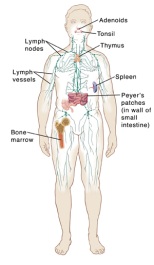The Immune System
What is the immune system?
The immune system works to keep germs and other foreign substances out of the body and destroy any that get in. It's made up of a complicated network of cells and organs. It protects the body from infection, cancer, and other conditions.
 |
| The Immune System - Click to Enlarge |
Lymph nodes are part of the immune system. They send out lymphocytes. These are a certain type of white blood cell that fights infection. The blood vessels and lymph vessels carry the lymphocytes to and from different areas in the body. Each lymph organ plays a role in making and activating lymphocytes. Organs in the lymph system include:
-
Adenoids. Two glands that are at the back of the nasal passage.
-
Blood vessels. These are the arteries, veins, and capillaries that blood flows through.
-
Bone marrow. This soft, fatty tissue is found inside bones where blood cells are made.
-
Lymph nodes. These small organs are shaped like beans. They are found all over the body. They connect through the lymphatic vessels.
-
Lymph vessels. This network of channels all over the body carry lymphocytes to the lymph organs and bloodstream.
-
Peyer's patches. This lymph tissue is in the small intestine.
-
Spleen. This fist-sized organ is located on the left side of the belly (abdomen).
-
Thymus. This small organ is located behind the breastbone.
-
Tonsils. These two oval masses are in the back of the throat.
What are lymphocytes?
Lymphocytes are a type of white blood cell that fights infection. They are vital to a healthy immune system.
How are lymphocytes formed?
Blood cells and immune cells are made in the bone marrow, thymus, lymph nodes, and tissues. Certain cells will become part of the group of lymphocytes. Others will become part of another type of immune cell called phagocytes. Once the lymphocytes are formed, some will continue to grow in the bone marrow and become B cells. Other lymphocytes will finish growing in the thymus and become T cells. B and T cells are the two major groups of lymphocytes that recognize and attack germs.
Once mature, some lymphocytes will stay in the lymph organs. Others will keep moving around the body through the lymphatic vessels and bloodstream. They will also move into the organs and tissues of the body.
How do lymphocytes fight infection?
Each type of lymphocyte fights infection differently. But the goal of protecting the body from infection remains the same. The B cells make specific antibodies to fight germs. The T cells kill the germs by killing the body cells that are affected. T cells also release chemicals (cytokines). These are cellular messengers that help direct the inflammation to the site of the germs.
Other types of white blood cells are engulfing cells (phagocytes) and natural killer cells (cytotoxic cells). These cells actually destroy the germs.
What are disorders of the immune system?
When the immune system doesn't work correctly, it leaves you at risk for disease. Allergies and being very sensitive to certain substances may be considered immune system disorders. The immune system also plays a role in rejecting transplanted organs or tissue. Other examples of immune disorders include:
-
Autoimmune diseases, which include type 1 diabetes, rheumatoid arthritis, multiple sclerosis, lupus, and certain types of anemia (this is when your immune system attacks its own body's tissues).
-
Immunodeficiency diseases, which include AIDS and severe combined immunodeficiency (SCID).
What is an infectious disease?
An infectious disease is a condition caused by one or more of the following types of germs:
-
Viruses
-
Bacteria
-
Parasites
-
Fungi
Infectious diseases can range from common illnesses such as a cold to COVID-19 to long-term (chronic) treatable conditions such as HIV infection and herpes. They also include often deadly illnesses such as rabies and Ebola. Depending on the disease-causing germ, an infectious disease can be spread through some or all of the following ways:
-
Sexual contact, including vaginal, anal, and oral sex
-
Breathing in airborne droplets of the disease after an infected person coughs or sneezes
-
Contact with infected blood, such as when sharing hypodermic needles
-
Contact with an infected area on the skin
-
Insects such as mosquitoes or ticks that draw blood from an infected host and then bite a healthy person
-
Eating contaminated food
-
Contact with contaminated water
-
Other methods that can pass on a disease
In developed countries, most infections are spread through sexual contact and airborne, bloodborne, and direct skin contact.
How do antibiotics work against infections?
Antibiotic medicines are used to treat bacterial infections. Antibiotics don't work against viral infections, but there are some antiviral medicines that do. For some infections, no antibiotics will work any faster than what the body can do on its own. Other infections may not have an antibiotic known to work against them. Antibiotics that work for one type of germ may not work for others. Overusing or misusing antibiotics can lead to bacteria that can't be stopped by an antibiotic (antibiotic resistance). It is important to take antibiotics correctly. That means taking them as directed and for the full length of the prescription. Doing this will fully treat the infection.